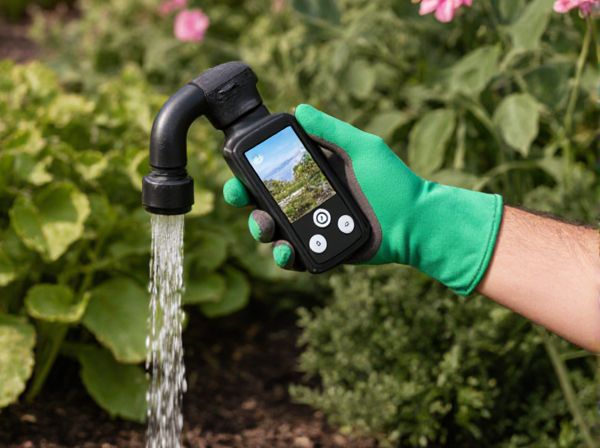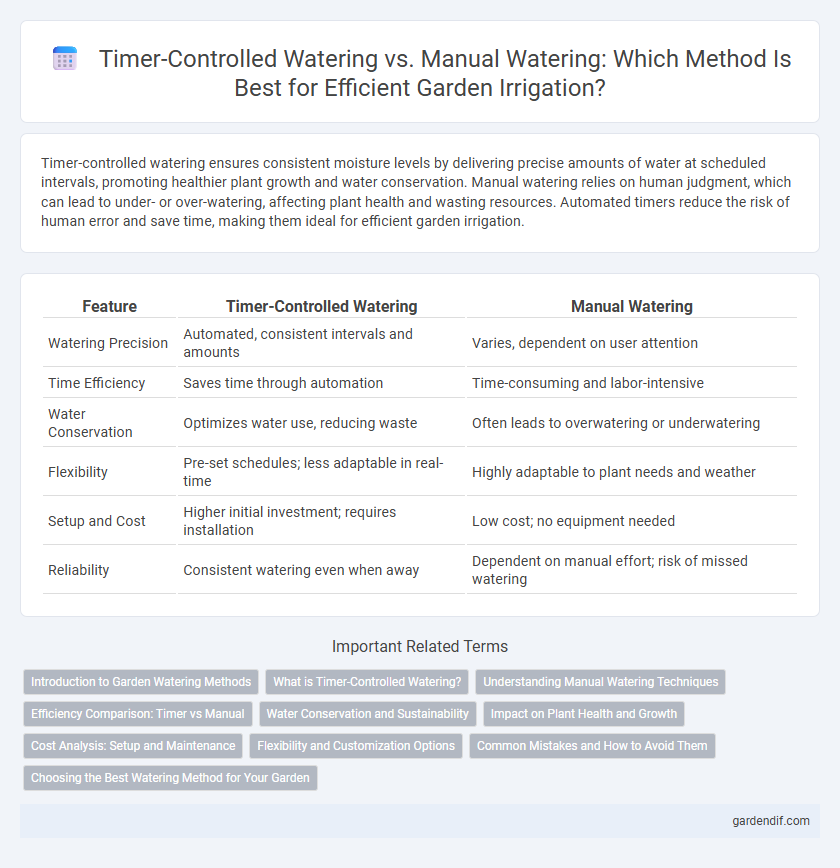
Timer-controlled watering vs Manual watering Illustration
Timer-controlled watering ensures consistent moisture levels by delivering precise amounts of water at scheduled intervals, promoting healthier plant growth and water conservation. Manual watering relies on human judgment, which can lead to under- or over-watering, affecting plant health and wasting resources. Automated timers reduce the risk of human error and save time, making them ideal for efficient garden irrigation.
Table of Comparison
| Feature | Timer-Controlled Watering | Manual Watering |
|---|---|---|
| Watering Precision | Automated, consistent intervals and amounts | Varies, dependent on user attention |
| Time Efficiency | Saves time through automation | Time-consuming and labor-intensive |
| Water Conservation | Optimizes water use, reducing waste | Often leads to overwatering or underwatering |
| Flexibility | Pre-set schedules; less adaptable in real-time | Highly adaptable to plant needs and weather |
| Setup and Cost | Higher initial investment; requires installation | Low cost; no equipment needed |
| Reliability | Consistent watering even when away | Dependent on manual effort; risk of missed watering |
Introduction to Garden Watering Methods
Timer-controlled watering systems provide precise control over watering schedules, ensuring consistent moisture levels tailored to specific plant needs and promoting optimal growth. Manual watering relies on direct human intervention, allowing flexibility to adjust watering based on immediate weather conditions but can lead to inconsistent hydration. Automated timers improve water efficiency and reduce waste by delivering water during ideal times, such as early morning or late evening, enhancing garden health and conserving resources.
What is Timer-Controlled Watering?
Timer-controlled watering automates irrigation by scheduling water release at preset intervals and durations, ensuring consistent moisture levels for plants. This system optimizes water use efficiency, reduces waste, and supports healthy root development by delivering precise amounts based on plant and soil needs. Compared to manual watering, timer-controlled watering offers convenience and reliability, especially in larger gardens or landscapes requiring uniform hydration.
Understanding Manual Watering Techniques
Manual watering techniques involve directly controlling the amount and frequency of water applied to plants, allowing gardeners to adjust based on soil moisture and plant needs. This method requires regular monitoring and knowledge of specific plant water requirements to avoid overwatering or underwatering. Effective manual watering enhances plant health by targeting roots precisely and minimizing water waste compared to timer-controlled systems.
Efficiency Comparison: Timer vs Manual
Timer-controlled watering systems deliver precise water amounts at optimal times, significantly reducing water waste and promoting consistent soil moisture levels. Manual watering often leads to overwatering or underwatering due to human error and inconsistent scheduling, decreasing overall irrigation efficiency. Studies show timer systems can improve water use efficiency by up to 30% compared to manual methods, enhancing plant health and conserving resources.
Water Conservation and Sustainability
Timer-controlled watering systems optimize water usage by delivering precise amounts at scheduled intervals, significantly reducing waste compared to manual watering. These systems adapt to plant needs and environmental conditions, promoting water conservation and enhancing sustainability in landscaping. Manual watering often leads to overwatering or inconsistent irrigation, increasing water consumption and diminishing efforts toward sustainable water management.
Impact on Plant Health and Growth
Timer-controlled watering ensures consistent moisture levels, promoting optimal root development and reducing stress caused by irregular watering patterns. Manual watering often leads to uneven hydration, risking either overwatering or drought stress, which can hinder plant growth and increase susceptibility to disease. Precise irrigation schedules supported by timers enhance nutrient uptake and overall plant vigor.
Cost Analysis: Setup and Maintenance
Timer-controlled watering systems require a higher initial investment due to the cost of timers, sensors, and automated valves, averaging between $100 to $500, but reduce long-term labor costs and water waste. Manual watering involves minimal setup expenses, typically just a hose or watering can, but increases ongoing labor time and may result in inefficient water use. Over time, timer-controlled systems offer cost savings through optimized water usage and reduced manual intervention, offsetting their upfront costs in maintenance and repair.
Flexibility and Customization Options
Timer-controlled watering offers precise scheduling and customizable watering durations, enabling optimal water use tailored to different plant needs and weather conditions. Manual watering provides immediate control and adaptability, allowing gardeners to respond to real-time soil moisture and plant health. Combining both methods enhances flexibility, ensuring plants receive appropriate hydration without overwatering or water waste.
Common Mistakes and How to Avoid Them
Timer-controlled watering systems often face issues like overwatering due to incorrect scheduling or failure to adjust settings for seasonal changes, leading to water wastage and plant stress. Manual watering commonly suffers from inconsistent frequency and uneven water distribution, which can cause root diseases and dry patches. To avoid these mistakes, regularly calibrate timers based on plant needs and weather patterns while applying manual watering evenly and monitoring soil moisture to ensure optimal hydration.
Choosing the Best Watering Method for Your Garden
Timer-controlled watering systems provide consistent moisture levels by delivering water at scheduled intervals, promoting healthier plant growth and conserving water. Manual watering offers flexibility to adjust watering based on immediate garden conditions but risks overwatering or underwatering due to human error. Selecting the best method depends on your garden's size, plant types, and personal availability for routine care, with timers benefiting busy gardeners and manual watering suiting those preferring hands-on control.
Timer-controlled watering vs Manual watering Infographic

 gardendif.com
gardendif.com